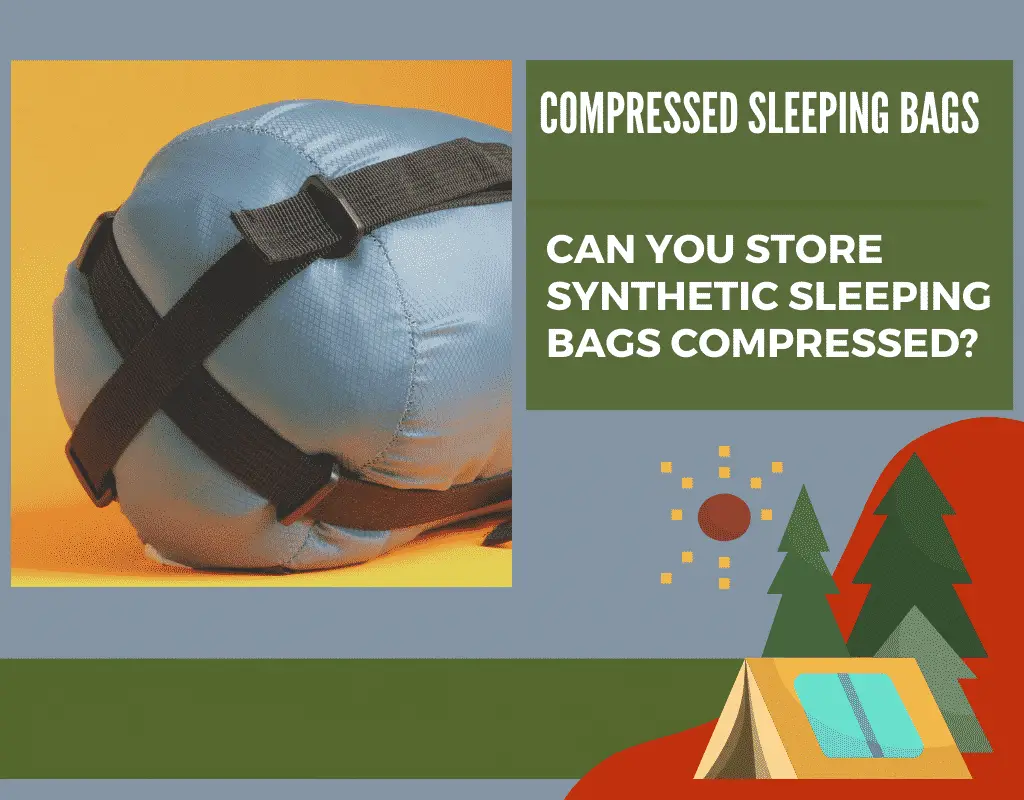At some point every backpackers starts to develop an obsession with buying gear you can pack down. We look at the packed size of tents, buy telescoping/collapsible gear, and look for sleeping bags that can pack down to almost nothing. Synthetic sleeping bags don’t have the same packability as down, but you can still compress them down to a fraction of their fluffed up size with a compression sack. That makes sense in your pack, but can you leave a synthetic sleeping bag compressed during long term storage?
Can you store synthetic sleeping bags compressed to save storage space? You should not store a synthetic sleeping bag in a compression sack. It won’t be as bad as storing down compressed, but it can compress synthetic insulation leaving creases in the insulation reducing warmth and cause mold/mildew growth. Most manufacturers recommend storing synthetic sleeping bags in a loose/large breathable cotton or mesh stuff sack.
There are synthetic sleeping bags that are labeled as crush proof (loose filling), but the vast majority of synthetic sleeping bags shouldn’t be stored compressed. I’ll go into a more detailed explanation of crushproof bags below, but lets start off by talking about compressing a typical synthetic sleeping bag.
Table Of Contents
Can you store synthetic sleeping bags compressed?
It would be crazy not to use a sleeping bag compression sack on a backpacking or camping trip. My sleeping bag would take up 90% of my pack if I didn’t use a compression sack. I use a 14Liter Sea To Summit Event Compression Sack whenever I’m backpacking. It keeps my sleeping dry and packs down into a 18″x8″ cylinder.
Storing a synthetic sleeping bag in a compression sack makes sense on a short trip, but what about long term storage? Can you store synthetic sleeping bags compressed?
Compressing a sleeping bag for a few weeks won’t cause any problems, but compressing a sleeping bag in storage can damage the bag. Here’s why you shouldn’t store a synthetic sleeping bag in a compression sack.
- Leaves Folds In The Insulation Layer: Most sleeping bags use sheets of bonded polyester insulation. When you compress a sleeping bag those sheets fold up into an awkward shape. Leaving the bag compressed will leave permanent folds in the insulation damaging the loft.
- Pulls Insulation Away From The Seams: As the insulation layer starts to fold and deform it will pull away from the outside edges of your sleeping bag. This leaves cold spots where there’s no insulation and increases drafts through the bag.
- Increases Risk Of Mold and Mildew: Most compression sacks are waterproof so you can run into mold and mildew problems. Sleeping bags pick up a lot of moisture throughout a camping trip and you need to give the bag time to completely dry out. That’s not possible in a waterproof compression sack.
Just understand that not every synthetic sleeping bag uses bonded sheets of insulation. Bags that use loose fill insulation like polyfill won’t get damaged by compression stuff sacks. You still have to watch out for mold/mildew problems, but loose insulation quickly bounces back to its original shape. Baffles keep loose fill in place, but you may have to adjust clumped together fill after using a compression sack.
I’ll explain the difference between loose and bonded insulation below, but lets first go over how to store synthetic sleeping bags.
How To Store A Synthetic Sleeping Bag Long Term
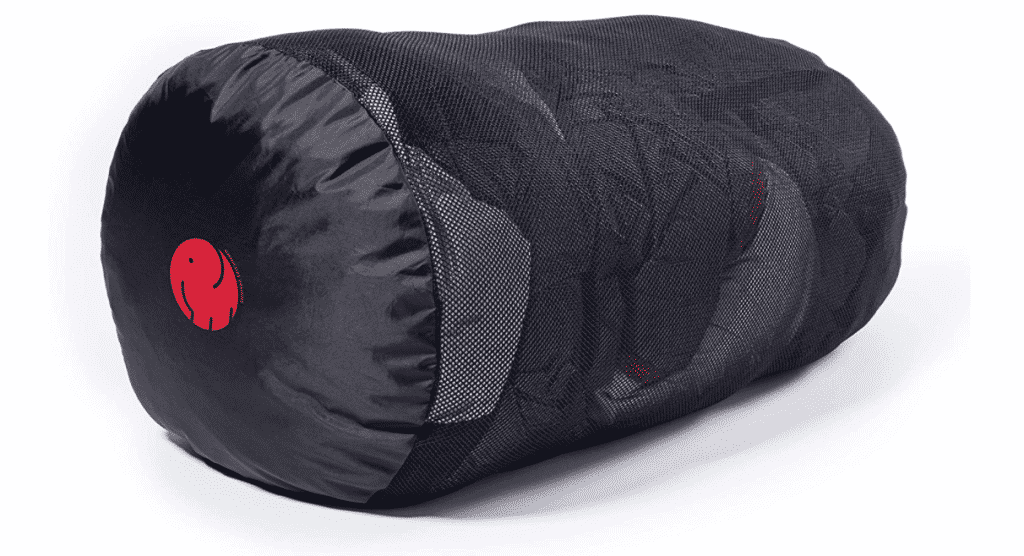
Storing your synthetic sleeping bag at home is simple, but it’s fairly easy to mess up ruining your gear. Making sure your sleeping bag is dry is by far the most important step. People seem to forget how much sweat, condensation, and moisture soaks into the insulation layer. The outside of your bag can feel completely dry and the inside can still have trapped moisture.
How do you store a synthetic sleeping bag?
- Remove Sleeping Bags From Compression Sacks and Waterproof Dry Bags: Take your synthetic sleeping bag out of its waterproof stuff sack or compression sack. Compression stuff sacks can compress and cause clumps to form in your insulation layer. This will cause cold spots in your sleeping bag. I will talk about crushproof sleeping bags that are better at maintaining loft in a compression sack below.
- Dry out your sleeping bag: Make sure your sleeping bag is completely dry before putting it into storage. Synthetic insulation can absorb moisture without feeling wet so there may be moisture trapped in your bag without you realizing it.
- Store Synthetic Sleeping Bags In Mesh/Cotton Stuff Sacks: Stow your sleeping bag loosely inside a breathable cotton or mesh stuff sack. Mesh and cotton bags give allow trapped moisture to evaporate in storage, but it will let in outside moisture so keep your bag in dry storage. I like to use the 9L Sea To Summit Mesh Sack to store my sleeping bag. It’s big enough to store my sleeping bag and 2-3 insulated jackets.
- Put Your Sleeping Bag In A Cool Dry Place For Long Storage: Store your sleeping bag in a place that’s cool and dry to prevent mold/mildew growth. Any closet or temperature controlled storage area will work. You can store your sleeping bag in water resistant plastic containers in your garage or basement, but make sure the bag has plenty of time to dry. I like to keep my bags tucked away in a mesh bag in the bottom of my closet and then move them into long term storage in my garage after 2-3 weeks.
Bonded vs Loose Fill Synthetic Insulation
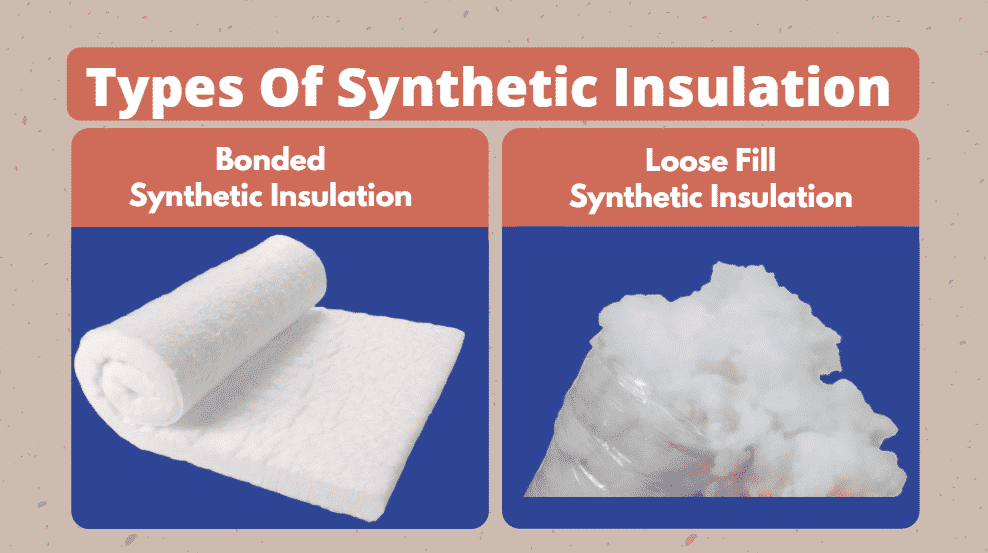
The vast majority of synthetic sleeping bags use bonded insulation since it’s cheap and won’t require baffles in the bag. This keeps manufacturing prices down and prevents shifting insulation in the bag. That sounds great on paper, but bonded insulation is heavy and doesn’t pack down.
That’s where loose fill insulation comes in. Loose fill insulation is lightweight, packs down similar to down, and resists crushing. It’s not as light as down insulation, but it’s water resistant and less likely to get damaged. Loose fill insulation (like polyfill) perform similarly to low fill power down insulation.
Here’s a brief breakdown of the difference between bonded and loose fill insulation.
- Bonded Synthetic Sleeping Bag Insulation: Bonded synthetic insulation comes in sheets that cover the entire width of the sleeping bag baffle. Bonded fill will be is easier to take care of since it won’t shift when used properly, but it will crease with long term storage in a compression sack.
- Loose Fill Synthetic Sleeping Bag Insulation: Loose fill insulation tries to mimic down. It uses loose synthetic fibers making loose fill bags light and highly compressible. It won’t be as light as down insulation, but it packs better than bonded insulation and won’t get damaged through compression.
A synthetic sleeping bag with baffles usually means that it uses crushproof loose fill synthetic insulation (like polyfill). Loose fill insulation uses individual clumps of polyester fill that’s very similar to down so it needs baffles to keep it in place.
Loose fill insulation is better at bouncing back from long term compression since it won’t fold in on itself. You still have to check for clumping and displacement in the bag, but baffles should help control movement.
I’ll go over crushproof synthetic sleeping bags in detail at the bottom of this post, but lets talk about why compression damages bonded synthetic insulation.
Compressing Synthetic Sleeping Bags Can Damage Your Bag
There are three main reasons why it’s bad to store a synthetic sleeping bag in a compression sack. It will create folds in the sheets of synthetic insulation. Pull the insulation away from the sides of the bag causing drafts and cold spots. Increase the chance of moisture issues that can lead to mold and mildew.
The vast majority of synthetic sleeping bags use sheets of bonded polyester that get damaged by prolonged compression, but there are crushproof synthetic bags. Premium bags use loose fill synthetic insulation so they won’t be damaged by compression, but it’s still a good idea to use a mesh or cotton storage bag to prevent mold/mildew problems.
I’ll talk about crushproof synthetic bags later, but how do compression sacks damage synthetic sleeping bags in storage?
Storing Synthetic Sleeping Bags Compressed Leaves Folds In Bonded Insulation
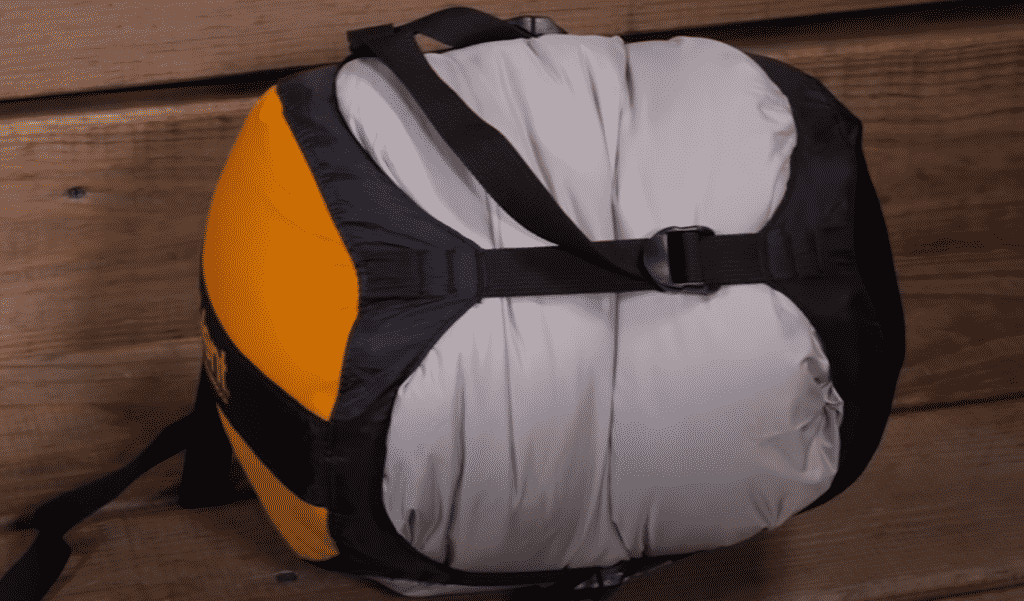
Here’s a simple comparison that will help explain the problem. Have you ever rolled up a rug and put it into long term storage? Leaving a rug rolled up for a few months won’t be an issue, but it will eventually develop creases and never go back to the original shape. When you take the bag out of storage it will have curled edges and creases wherever it was held in an unnatural position.
That’s the same thing that happens when you store synthetic sleeping bags compressed. It will bounce back to its original shape with short term storage (2-3 months), but compressing it over the long term will leave folds in the insulation.
Most synthetic sleeping bags use polyester fiber insulation that’s bound into sheets that run along the the bag. You can tell what type of insulation your bag uses by looking at the baffled seams that run across the width of the bag. Bound sheets of insulation won’t use baffles since there’s less of a chance of shifting insulation.
When you compress a synthetic sleeping bag that uses sheets of bonded insulation, the sheets will start to fold and deform. Each of those folds creates areas where the insulation won’t be able to bounce back. So every one of those folds creates cold pockets that will speed up the loss of body heat.
Compression Pulls Insulation Away From Sleeping Bag Edges
Prolonged compression and distortion of the synthetic insulation layer will also pull the filling away from your sleeping bag’s seams. This means that there will be less insulation in the edges of your bag, which cause cold spots.
So you’ll be left with multiple small areas in your sleeping bag with little to no insulation. This won’t be completely avoided with proper storage, but it will help slow down the degradation of your bag. The temperature rating will slowly drop as time goes on.
Sleeping Bag Compression Sacks Trap Moisture
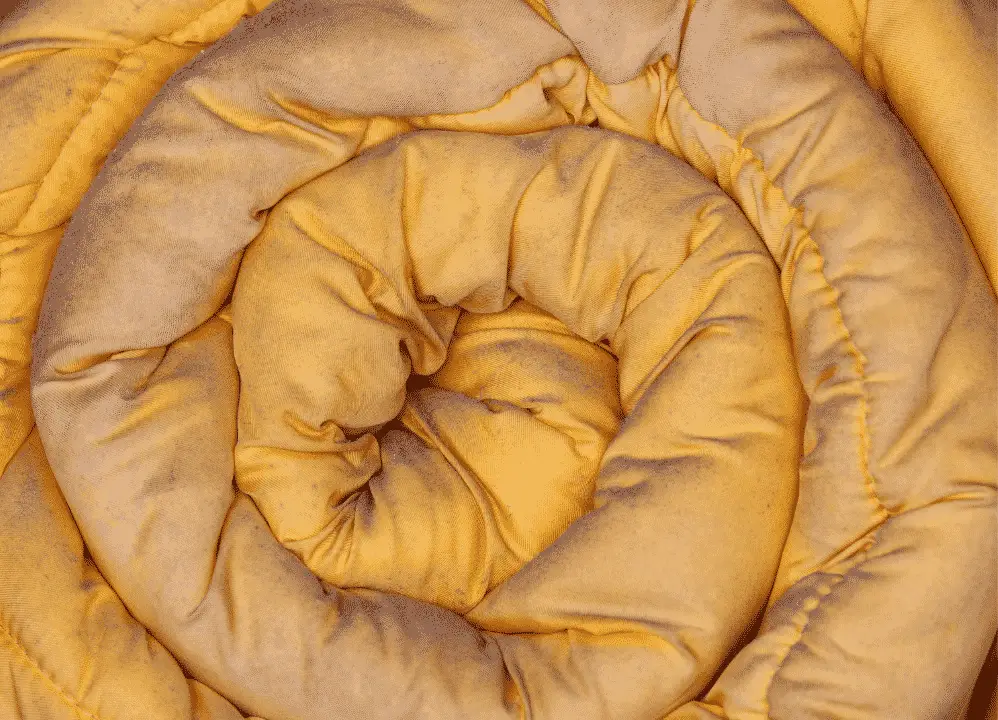
The vast majority of sleeping bag compression sacks are 100% waterproof or at least water resistant. That’s great for keeping your sleeping bag dry in your pack, but it causes serious problems in long term storage.
Storing a sleeping bag in any type of waterproof bag will cause serious moisture issues. Synthetic sleeping bag insulation resists moisture and are better at maintaining warmth when wet, but you can still run into mold and moisture issues.
It doesn’t matter where your sleeping bag is stored. There will always be moisture trapped in the sleeping bag! You will obviously run into more problems storing your bag in a damp garage or basement, but mold/mildew can also be an issue in a temperature controlled closet or storage area.
Proper sleeping bag storage isn’t just about keeping water out of the bag. You also need to allow trapped moisture to escape. This means keeping it out of waterproof bags and plastic storage containers that won’t allow water to evaporate.
Give Your Synthetic Sleeping Bag Time To Dry
You’re probably asking yourself how can your sleeping bag grow mold/mildew if there’s no outside moisture? You can go to extreme lengths to keep outside moisture out of your sleeping bag, but there will always be water that gets to your sleeping bag.
I use a pack liner, waterproof compression sack (this one), rain cover on my pack in bad weather, and still dealt with moisture issues after getting home. Think about all of the sweat, body oils, condensation, and random exterior moisture that gets into a sleeping bag on a typical camping trip.
The average person sweats out 2 liters of water throughout the night and most of it will be absorbed into your sleeping bag. Then you have to think about outside moisture and condensation. Sleeping bag liners help some (I use this one), but there’s no way to keep your bag completely dry.
That’s why you should always use a cotton or mesh sleeping bag sack after a long camping trip. Mesh storage sacks are cheap so there’s no reason not to buy one. I use a 9 liter Sea To Summit Mesh Sack to store my sleeping bag and down/synthetic jackets. It gives your insulation layers time to breathe and speeds up the evaporation time.
You Can Store Completely Dry Synthetic Sleeping Bags In Plastic Containers
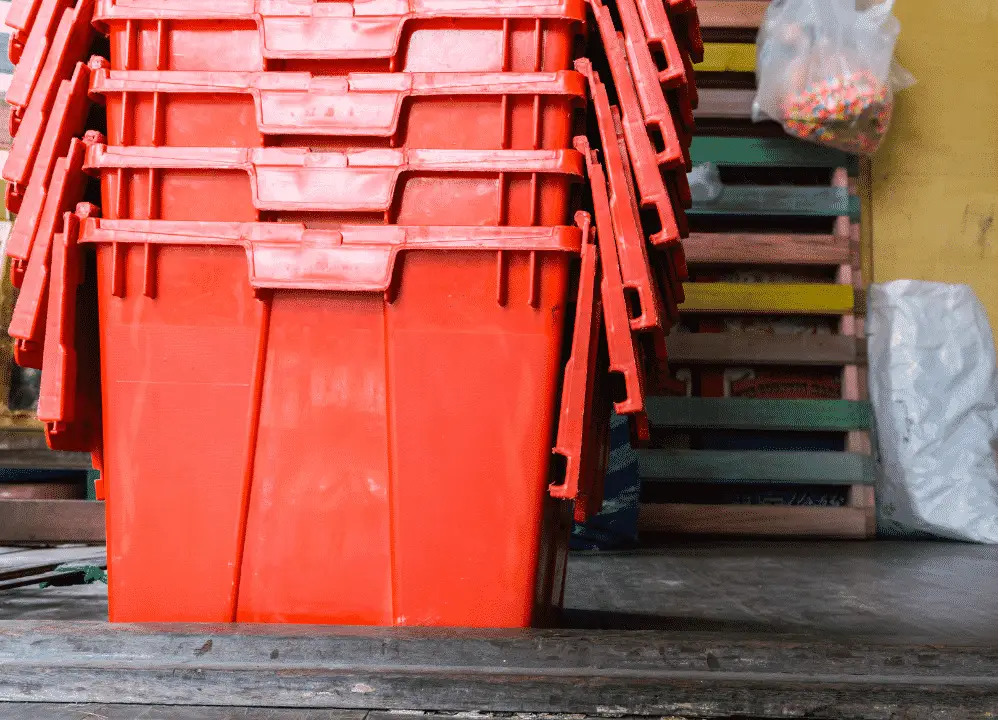
I’m not saying that you can’t ever put your sleeping bag in a plastic container. Just make sure you give the bag enough time to completely dry out after using it. Mesh or cotton stuff sacks are great for promoting evaporation in the short term, but you sometimes need to use a waterproof storage container or waterproof bag.
I don’t have enough closet space to store my camping gear in a temperature controlled environment. So most of my gear goes into my unfinished basement or out to the garage. Just make sure you give your gear enough time to completely dry before putting it in a waterproof container.
All of my gear gets tucked away in water resistant plastic containers so they’re easier to stack. It keeps everything in one place and protects my gear against humidity. All of my insulation layers go in one container, and hard gear like cooking equipment, stakes, tools, first aid kit, etc. go in another. This keeps all of my gear organized, out of the way, and in one convenient place when I need it.
Look For Crush Proof Loose Fill Synthetic Sleeping Bags
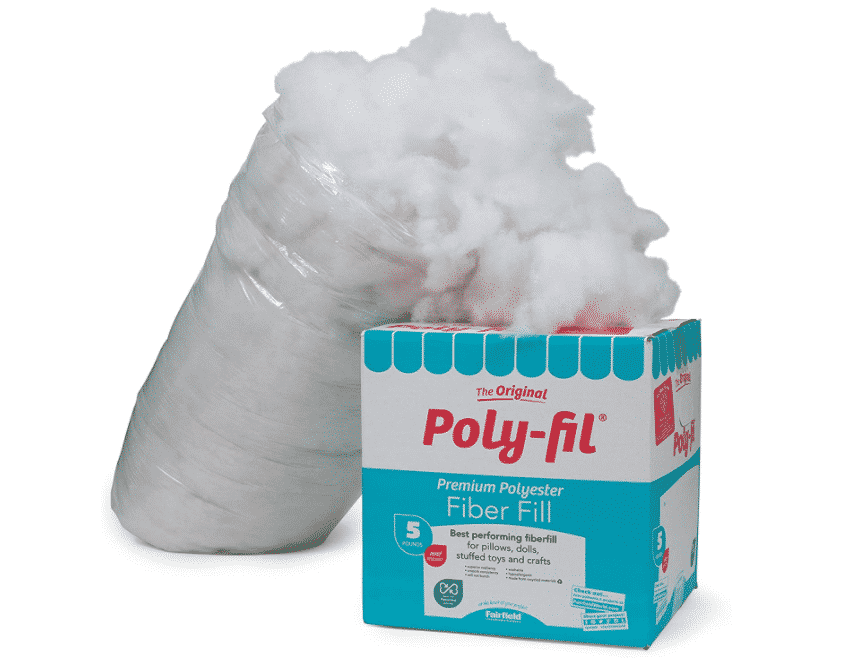
As I mentioned above, not every sleeping bag uses sheets of synthetic insulation to provide warmth. Companies have developed crush proof loose fill sleeping bag insulation that bounces back faster after being compressed, reduces weight, and increases the packability of the bag.
Since loose fill synthetic insulation isn’t bounded in sheets it won’t get damaged from extended compression. It might take a few minutes to bounce back after being compressed, but you won’t get creases and cold areas in the bag. You just have to keep an eye on the baffles to prevent insulation clumps and shifting in the bag.
Unfortunately, companies use different name for their synthetic loose fill insulation so you’ll have to look into what type of insulation your sleeping bag uses. Polyfill is by far the most popularly used loose fill insulation that replicates down, but some companies use their own brand names (Polarloft, Cirroloft, etc.).
It can be hard to tell what type of synthetic insulation your sleeping bag uses from the technical specs. The easiest way to tell is by checking to see if the synthetic bag has baffles. Most bags that use bonded insulation don’t have baffles running across the bag since bonded insulation won’t move across the bag. You can also feel the insulation to see how it moves in the bag.
When the insulation feels like a solid sheet that pulls and moves as a single unit, you have bonded insulation. Pulling insulation at one side of the baffle will pull it away from the other end. If you can move the insulation around from one area of the bag to the other it’s a loose fill synthetic. It will move around like insulation and clump up as you force it from one are to the other.
